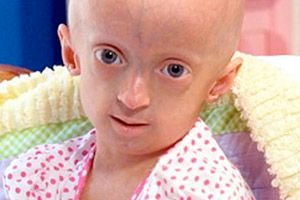
All iLive content is medically reviewed or fact checked to ensure as much factual accuracy as possible.
We have strict sourcing guidelines and only link to reputable media sites, academic research institutions and, whenever possible, medically peer reviewed studies. Note that the numbers in parentheses ([1], [2], etc.) are clickable links to these studies.
If you feel that any of our content is inaccurate, out-of-date, or otherwise questionable, please select it and press Ctrl + Enter.
Pediatric progeria (Getchinson-Gilford syndrome)
Medical expert of the article
Last reviewed: 04.07.2025

Childhood progeria (syn. Hutchinson-Gilford syndrome) is a rare, probably genetically heterogeneous disease, with a predominantly autosomal recessive type of inheritance, the possibility of a new dominant mutation is not excluded. It is characterized by age-related changes in the body in childhood with a fatal outcome, often occurring before the age of 15 from complications caused by atherosclerosis.
Pathogenesis
Atrophic changes in the epidermis and dermis, thinning of the subcutaneous fat are revealed. In the area of skin compaction, the epidermis is of normal thickness and structure, the dermis is sharply thickened, in its lower part there is hyalinization of collagen fibers, spreading into the subcutaneous tissue in the form of layers. In the upper part of the dermis - moderate perivascular inflammatory infiltrates. The terminal sections of the sweat glands are located higher than normal.
In the culture of fibroblasts obtained from patients and their heterozygous parents, a slowdown in cell growth, a decrease in mitotic activity, DNA synthesis and cloning ability were detected. In a hybrid of fibroblasts from patients with Ehrlich ascites cells from mice, thymidine absorption was sharply reduced.
Symptoms pediatric progeria
The skin is thin, dry, wrinkled, with translucent veins, there is pronounced muscle and subcutaneous tissue atrophy, dystrophy of teeth and nails, changes in the bone and joint apparatus, myocardium, clouding of the lens, lipid metabolism disorder. The disease usually manifests itself at the age of 6-12 months with growth retardation, hair loss on the scalp, in the eyebrow and eyelash area. There is a discrepancy between the volume of the skull and the small face, underdevelopment of the lower jaw, a beak-shaped nose, and cyanosis around the mouth. The skin of the trunk is thin, pigmented, with sclera-like plaques. Hypoplasia of the genitals is observed, secondary sexual characteristics are absent.


 [
[ 